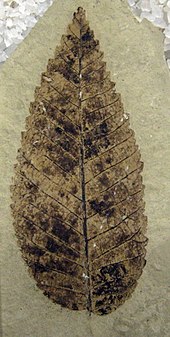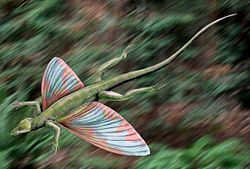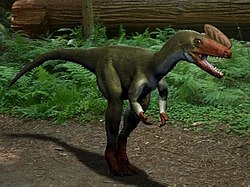| |||
|---|---|---|---|
| +... | |||
Paleontology or palaeontology is the study of prehistoric life forms on Earth through the examination of plant and animal fossils . [1] This includes the study of body fossils, tracks ( ichnites ), burrows , cast-off parts, fossilised feces ( coprolites ), palynomorphs and chemical residues . Because humans have encountered fossils for millennia, paleontology has a long history both before and after becoming formalized as a science . This article records significant discoveries and events related to paleontology that occurred or were published in the year 1926.
| Name | Novelty | Status | Authors | Age | Unit | Location | Notes | Images |
|---|---|---|---|---|---|---|---|---|
Gen et sp nov | jr synonym | Latah Formation | A moss of uncertain affiliation |  | ||||
Gen et sp nov | valid? | Latah Formation | A possible polytrichaceous moss |  | ||||
| Name | Novelty | Status | Authors | Age | Unit | Location | Notes | Images |
|---|---|---|---|---|---|---|---|---|
Sp nov | Nomen dubium? | Latah Formation | A possible lycopod clubmoss |  | ||||
| Name | Novelty | Status | Authors | Age | Unit | Location | Notes | Images |
|---|---|---|---|---|---|---|---|---|
Sp nov | jr synonym | Latah Formation | A sandarac species |  | ||||
Sp nov | jr synonym | Latah Formation | A plum-yew species |  | ||||
| Name | Novelty | Status | Authors | Age | Unit | Location | Notes | Images |
|---|---|---|---|---|---|---|---|---|
Sp nov | valid? | Latah Formation | A possible araceous monocot |  | ||||
Sp nov | jr synonym | A possible cannaceous leaf species | ||||||
| Name | Novelty | Status | Authors | Age | Unit | Location | Notes | Images |
|---|---|---|---|---|---|---|---|---|
Gen et comb nov | A Trochodenraceous leaf morphogenus. | |||||||
| Name | Novelty | Status | Authors | Age | Unit | Location | Notes | Images |
|---|---|---|---|---|---|---|---|---|
Sp nov | Jr synonym | Latah Formation | A persimmon leaf species |  | ||||
Sp nov | A persimmon leaf species | |||||||
Sp nov | Jr synonym | Latah Formation | First named as a persimmon calyx species. [3] |  | ||||
Sp nov | valid? | Latah Formation | First named as a huckleberry leaf species |  | ||||
| Name | Novelty | Status | Authors | Age | Unit | Location | Notes | Images |
|---|---|---|---|---|---|---|---|---|
Sp nov | An alder leaf species | |||||||
Sp nov | An alder leaf species | |||||||
Sp nov | jr synonym | Latah Formation | First named as a birch leaf species |  | ||||
Sp nov | jr synonym | Latah Formation | First named as a birch leaf species |  | ||||
Sp nov | jr synonym | Latah Formation | First named as a birch leaf species |  | ||||
Sp nov | jr synonym | Latah Formation | First named as a birch leaf species |  | ||||
Sp nov | jr synonym | First named as a birch leaf species |  | |||||
Sp nov | valid | Latah Formation | First named as a birch leaf species |  | ||||
Sp nov | A possible celastraceous leaf species | |||||||
Sp nov | jr synonym | Latah Formation | First named as a Celastrus leaf species |  | ||||
Sp nov | jr synonym | Latah Formation | First named as a redbud fruit species |  | ||||
Sp nov | A myricaceous leaf species | |||||||
Sp nov | A possible moraceous leaf species | |||||||
Sp nov | jr synonym | Latah Formation | First named as a fig leaf species |  | ||||
Sp nov | jr synonym | A punitive hickory leaf species | ||||||
comb nov | jr synonym | (Dawson) Berry | A punitive hickory leaf species | |||||
Sp nov | A juglandaceous leaf species | |||||||
Sp nov | A legume leaf morphospecies. | |||||||
Sp nov | jr synonym | Latah Formation | First named as a Meibomites leaf species | |||||
Sp nov | Jr synonym | A myricaceous leaf species | ||||||
Sp nov | A cottonwood leaf species | |||||||
Sp nov | jr synonym | Latah Formation | First named as a cottonwood leaf species |  | ||||
Sp nov | jr synonym | Latah Formation | First named as a cottonwood leaf species |  | ||||
Sp nov | jr synonym | Latah Formation | First named as a cottonwood leaf species |  | ||||
Sp nov | jr synonym | Latah Formation | First named as a cherry leaf species |  | ||||
Sp nov | jr synonym | Latah Formation | An oak leaf species |  | ||||
Sp nov | jr synonym | Latah Formation | An oak leaf species |  | ||||
Sp nov | jr synonym | Latah Formation | An oak leaf species |  | ||||
Sp nov | jr synonym | Latah Formation | An oak leaf species |  | ||||
Sp nov | jr synonym | Latah Formation | An oak leaf species |  | ||||
Sp nov | jr synonym | Latah Formation | First named as an oak leaf species |  | ||||
Sp nov | A oak leaf species | |||||||
Sp nov | A buckthorn leaf morphospecies. | |||||||
Sp nov | jr synonym | Latah Formation | A willow leaf species |  | ||||
Sp nov | jr synonym | Latah Formation | A willow leaf species |  | ||||
Sp nov | jr synonym | Latah Formation | A willow leaf species |  | ||||
Sp nov | jr synonym | Latah Formation | A Sophora leaf species |  | ||||
Sp nov | Latah Formation | A Sophora leaf species |  | |||||
Sp nov | A punitive mountain ash leaf species | |||||||
sp nov | jr homonym | An elm leaf species |  | |||||
Sp nov | jr synonym | Latah Formation | First named as an elm leaf species |  | ||||
| Name | Novelty | Status | Authors | Age | Unit | Location | Notes | Images |
|---|---|---|---|---|---|---|---|---|
Sp nov | Valid | Latah Formation | A maple species |  | ||||
Sp nov | jr synonym | Latah Formation | First named as a possible mallow fruit species |  | ||||
| Name | Novelty | Status | Authors | Age | Unit | Location | Notes | Images |
|---|---|---|---|---|---|---|---|---|
Sp nov | valid? | Latah Formation | A fruit or seed of uncertain affinity |  | ||||
Sp nov | valid? | Latah Formation | A fruit or seed of uncertain affinity |  | ||||
Sp nov | valid? | Latah Formation | A fruit or seed of uncertain affinity |  | ||||
Sp nov | jr synonym | Latah Formation | First named as a fruit of uncertain affinity |  | ||||
Sp nov | jr synonym | Latah Formation | A fruit or seed of uncertain affinity |  | ||||
Sp nov | valid? | Latah Formation | A fruit or seed of uncertain affinity |  | ||||
Sp nov | valid? | Latah Formation | Seed or other reproductive organs of uncertain affinity |  | ||||
Sp nov | jr synonym | Latah Formation | First named as a fruit of uncertain affinity |  | ||||
Sp nov | jr synonym | Latah Formation | First named as a leaf of uncertain affinity |  | ||||
Sp nov | jr synonym | Latah Formation | First named as a leaf of uncertain affinity |  | ||||
Sp nov | jr synonym | Latah Formation | First named as a leaf of uncertain affinity |  | ||||
Sp nov | jr synonym | Latah Formation | First named as a leaf of uncertain affinity |  | ||||
Sp nov | jr synonym | Latah Formation | First named as a leaf of uncertain affinity |  | ||||
| Name | Novelty | Status | Authors | Age | Unit | Location | Notes | Images |
|---|---|---|---|---|---|---|---|---|
Valid | ||||||||
| Name | Novelty | Status | Authors | Age | Unit | Location | Notes | Images |
|---|---|---|---|---|---|---|---|---|
Gen et comb nov | jr synonym | Watson | A new genus for Macromerium scoticum |  |
| Name | Novelty | Status | Authors | Age | Unit | Location | Notes | Images |
|---|---|---|---|---|---|---|---|---|
Valid | A weigeltisaurid gliding Reptile |  | ||||||
| Taxon | Novelty | Status | Author(s) | Age | Unit | Location | Notes | Images |
|---|---|---|---|---|---|---|---|---|
| Proceratosaurus [23] | Gen. nov. | Valid | von Huene | Bathonian | Forest Marble Formation | A new genus name for Megalosaurus bradleyi |  | |
| Rhoetosaurus brownei [24] | Gen. et sp. nov. | Valid | Longman | Oxfordian | Walloon Coal Measures | An early sauropod | ||
| Thespesius saskatchewanensis [25] | Sp. nov. | Jr. synonym | Sternberg | Maastrichtian | Frenchman Formation | A species of Thespesius now a synonym of Edmontosaurus annectens | ||
| Name | Novelty | Status | Authors | Age | Unit | Location | Notes | Images |
|---|---|---|---|---|---|---|---|---|
Junior synonym | Haughton | A junior synonym of Gorgonops . | ||||||
Junior synonym | Haughton | Late Permian | A junior synonym of Aelurognathus . | |||||